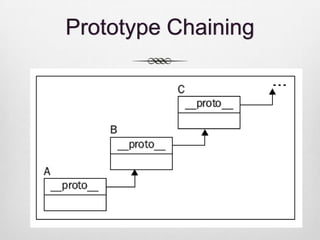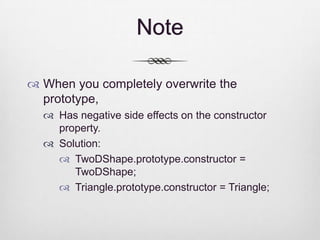Object Oriented JavaScript
- 2. Lecture Outline Object-Oriented JavaScript Inheritance
- 4. Objects Is a self-contained collection of data. The data can be properties, a variable belonging to an object. methods, a function that the object can invoke, an object in itself. Properties and methods are both accessed using dot notation.
- 5. Objects (Cont’d) No class, classless approach Objects are created through: Literal notation using { } Constructors function
- 6. Using object literal notation{} To create an empty object var x={} To create an object with properties and methods var student={ track:"PD", marks:[100,200,300], getTotal: function () { var sum=0; for(var i in this.marks) sum+=this.marks[i]; return sum; } }
- 7. Accessing Properties Using square bracket notation student[„track‟] PD Using the dot notation, student.track PD
- 8. Objects inside Objects Example var book = { name: 'Catch-22', published: 1961, author: { firstname: 'Joseph', lastname: 'Heller' } }; book.author.firstname book['author']['lastname']
- 9. Delete a Property delete student.track;
- 10. Using Constructor function function student(name) { this.track="PD”; this.name=name; this.marks=[100,200,300]; this.getTotal= function () { var sum=0; for(var i in this.marks) sum+=this.marks[i]; return sum; }; } To create an object, use new operator var std = new student(“Smith”);
- 11. What happens when you create an object without ‘new’ operator? var std =student() this refers to global object ‘window’ std undefined or whatever constructor returns if it returns anything
- 12. Try Objects Use Developer tools
- 13. constructor Property It contains a reference to the constructor function used to create this object. std.constructor student(name) var h3 = new std.constructor('Rafaello'); If an object was created using the object literal notation?? its constructor is the built-in Object() constructor function. var o = {}; o.constructor Object() empty object typeof o.constructor "function"
- 14. Passing Objects When you copy an object or pass it to a function, you only pass a reference to that object. Consequently, if you make a change to the reference, you are actually modifying the original object. Example var original = {howmany: 1}; var copy = original; copy.howmany 1 copy.howmany = 100; original.howmany 100 The same thing applies when passing objects to functions:
- 15. Comparing Objects true iff you compare two references to the same object. >>> var fido = {breed: 'dog'}; var benji = {breed: 'dog'}; benji == fido false However var mydog = benji; mydog == benji true
- 16. Object object Object is the parent of all JavaScript objects Every object created inherits from it. To create a new empty object var o = {}; var o = new Object(); Properties: o.constructor property returns the constructor function o.toString() is a method that returns a string representation of the object o.valueOf() returns a single-value representation of the object, often this is the object itself
- 17. Private Members Ordinary ’var’ of the constructor are private members. function Container(param) { this.member = param; var secret = 3; var that = this; } secret and that are attached to the object, but they are not accessible to the outside, nor are they accessible to the object's own public methods. They are accessible to private methods.
- 18. Private Methods function Container(param) { function dec() { if (secret > 0) { secret -= 1; return true; } else {return false;} } this.member = param; var secret = 3; var that = this; }
- 19. Privileged Method Is able to access the private variables and methods, and is itself public. this.service = function () { return dec() ? that.member : null; }; Private and privileged members can only be made when an object is constructed (in a constructor).
- 21. Inheritance Used for code reuse JavaScript don’t use class-inheritance but prototype- inheritance (based on Objects) There are many ways to implement inheritance. We will cover Prototype Chaining
- 22. Function Object Properties: length: number of arguments constructor: Function() prototype: initially is an empty object
- 23. Prototype JavaScript prototype-based object model Every function object has a prototype property, Initially empty Object Augment this empty object with properties and methods. Only be used when function is used as a constructor.
- 24. Adding Methods and Properties function Gadget.prototype.price = 100; Gadget(name, color) { this.name = name; Gadget.prototype.rating = 3; this.color = color; Gadget.prototype.getInfo = this.whatAreYou = function() { function() return 'Rating: ' + this.rating + { ', price: ' + this.price; return 'I am a ' + this.color + ' ' + this.name; }; } }
- 25. What if object contain a property defined in prototype? Own Property overrides prototype property propertyIsEnumerable() hasOwnProperty() isPrototypeOf()
- 26. What is the result? function Gadget(name, color) var newtoy = new Gadget('webcam', 'black'); { for (var prop in newtoy) this.name = name; { this.color = color; console.log(prop + ' = ' + this.someMethod = function(){return 1;} newtoy[prop]); } } name = webcam Gadget.prototype.price = 100; color = black someMethod = function () { return 1; } Gadget.prototype.rating = 3; price = 100 rating = 3
- 27. What is the result? function var newtoy = new Gadget(name, color) Gadget('webcam', 'black'); { for (var prop in newtoy) { this.name = name; if (newtoy.hasOwnProperty(prop)) this.color = color; { this.someMethod = console.log(prop + '=' + function(){return 1;} newtoy[prop]); } } } Gadget.prototype.price = 100; name = webcam Gadget.prototype.rating = 3; color = black someMethod = function () { return 1; }
- 28. Augmenting Built-in Objects Array.prototype.inArray = function(needle) { for (var i = 0, len = this.length; i < len; i++) { if (this[i] === needle) { return true; } } return false; }
- 30. function Shape(){ this.name = 'shape'; this.toString = function() {return this.name;}; } function TwoDShape(){ Inheritance is done through: this.name = '2D shape'; TwoDShape.prototype } = new Shape(); function Triangle.prototype = Triangle(side, height) { new TwoDShape(); this.name = 'Triangle'; this.side = side; this.height = height; this.getArea = function(){return this.side * this.height / 2;}; }
- 31. Note When you completely overwrite the prototype, Has negative side effects on the constructor property. Solution: TwoDShape.prototype.constructor = TwoDShape; Triangle.prototype.constructor = Triangle;
- 32. What do the JavaScript engine does when you call my.toString()? var my=new Triangle(5,10) Loops through all of the properties of my If not found, looks at the object that my.__proto__ points to; the instance of TwoDShape() . Loops through the instance of TwoDShape. If not found, checks the __proto__ of that object that points to the instance of Shape(). Loops through the instance of Shape() and toString() is finally found!
- 33. For efficiency: Moving shared properties to the prototype function Shape(){} function Triangle(side, height) { Shape.prototype.name = 'shape'; this.side = side; Shape.prototype.toString = function() this.height = height; {return this.name;}; } function TwoDShape(){} Triangle.prototype = new TwoDShape.prototype = new TwoDShape(); Shape(); Triangle.prototype.constructor = TwoDShape.prototype.constructor = Triangle; TwoDShape; TwoDShape.prototype.name = '2D Triangle.prototype.name = 'Triangle'; shape'; Triangle.prototype.getArea = function(){return this.side * this.height / 2;};
- 34. References Object-Oriented JavaScript Create Scalable, reusable, high quality JavaScript applications and libraries, Stoyan Stefanov, 2008. http://www.quirksmode.org/js
Editor's Notes
- #19: By convention, we make a private ‘that’ variable. This is used to make the object available to the private methods. This is a workaround for an error in the ECMAScript Language Specification, which causes this to be set incorrectly for inner functions (private methods).Private methods cannot be called by public methods. To make private methods useful, we need to introduce a privileged method.
- #25: var newtoy = new Gadget('webcam', 'black');newtoy.name;"webcam"newtoy.color;"black"newtoy.whatAreYou();"I am a black webcam"newtoy.price;100newtoy.rating;3newtoy.getInfo();"Rating: 3, price: 100"
- #29: var a = ['red', 'green', 'blue'];a.inArray('red');truea.inArray('yellow');false
- #30: Instead of augmenting an object with individual properties or methods we can specify another object as the prototype object. Thus, making an object inherit all properties of another object.
- #34: isPrototypeOf() to check whether an object inherits another or no






![Using object literal
notation{}
To create an empty object
var x={}
To create an object with properties and methods
var student={
track:"PD",
marks:[100,200,300],
getTotal: function ()
{
var sum=0;
for(var i in this.marks)
sum+=this.marks[i];
return sum;
}
}](https://image.slidesharecdn.com/lecture4-130108142925-phpapp02/85/Object-Oriented-JavaScript-6-320.jpg)
![Accessing Properties
Using square bracket notation
student[„track‟] PD
Using the dot notation,
student.track PD](https://image.slidesharecdn.com/lecture4-130108142925-phpapp02/85/Object-Oriented-JavaScript-7-320.jpg)
![Objects inside Objects
Example
var book = {
name: 'Catch-22',
published: 1961,
author: {
firstname: 'Joseph',
lastname: 'Heller'
}
};
book.author.firstname
book['author']['lastname']](https://image.slidesharecdn.com/lecture4-130108142925-phpapp02/85/Object-Oriented-JavaScript-8-320.jpg)

![Using Constructor function
function student(name) {
this.track="PD”;
this.name=name;
this.marks=[100,200,300];
this.getTotal= function ()
{
var sum=0;
for(var i in this.marks)
sum+=this.marks[i];
return sum;
};
}
To create an object, use new operator
var std = new student(“Smith”);](https://image.slidesharecdn.com/lecture4-130108142925-phpapp02/85/Object-Oriented-JavaScript-10-320.jpg)















![What is the result?
function Gadget(name, color) var newtoy = new
Gadget('webcam', 'black');
{ for (var prop in newtoy)
this.name = name;
{
this.color = color;
console.log(prop + ' = ' +
this.someMethod =
function(){return 1;} newtoy[prop]);
}
}
name = webcam
Gadget.prototype.price = 100; color = black
someMethod = function () { return 1; }
Gadget.prototype.rating = 3; price = 100
rating = 3](https://image.slidesharecdn.com/lecture4-130108142925-phpapp02/85/Object-Oriented-JavaScript-26-320.jpg)
![What is the result?
function var newtoy = new
Gadget(name, color) Gadget('webcam', 'black');
{ for (var prop in newtoy) {
this.name = name; if (newtoy.hasOwnProperty(prop))
this.color = color; {
this.someMethod = console.log(prop + '=' +
function(){return 1;} newtoy[prop]);
} }
}
Gadget.prototype.price =
100; name = webcam
Gadget.prototype.rating = 3; color = black
someMethod = function () { return 1; }](https://image.slidesharecdn.com/lecture4-130108142925-phpapp02/85/Object-Oriented-JavaScript-27-320.jpg)
![Augmenting Built-in
Objects
Array.prototype.inArray = function(needle) {
for (var i = 0, len = this.length; i < len; i++) {
if (this[i] === needle) {
return true;
}
}
return false;
}](https://image.slidesharecdn.com/lecture4-130108142925-phpapp02/85/Object-Oriented-JavaScript-28-320.jpg)





